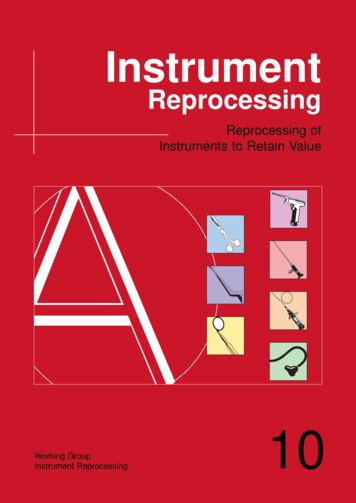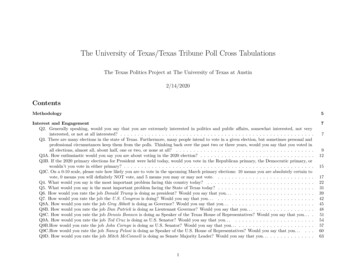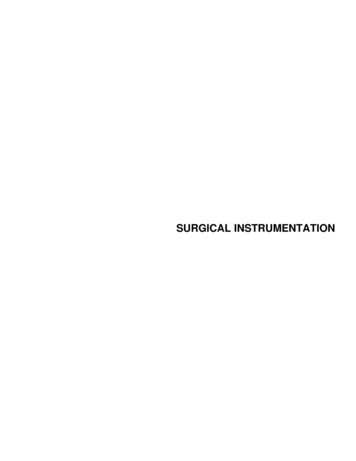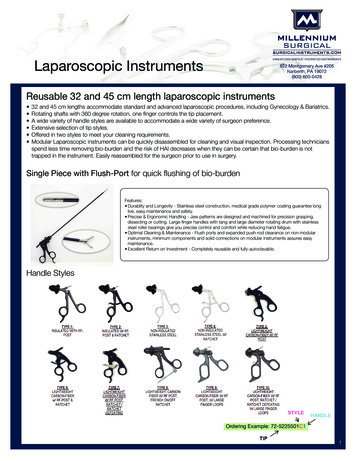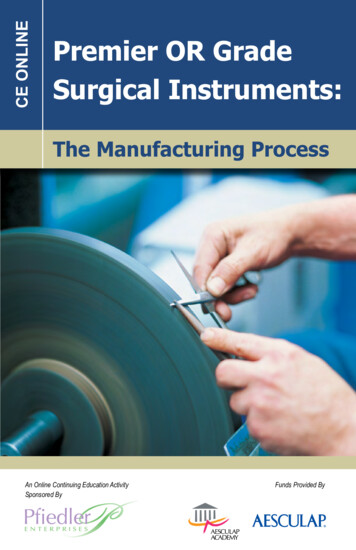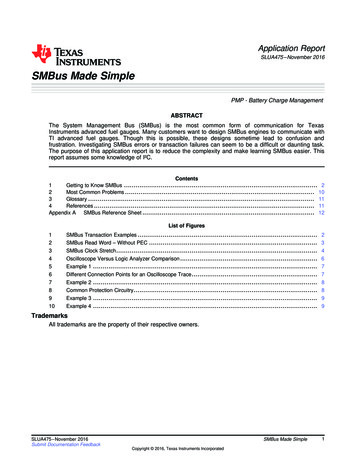
Transcription
Application ReportSLUA475 – November 2016SMBus Made Simple. PMP - Battery Charge ManagementABSTRACTThe System Management Bus (SMBus) is the most common form of communication for TexasInstruments advanced fuel gauges. Many customers want to design SMBus engines to communicate withTI advanced fuel gauges. Though this is possible, these designs sometime lead to confusion andfrustration. Investigating SMBus errors or transaction failures can seem to be a difficult or daunting task.The purpose of this application report is to reduce the complexity and make learning SMBus easier. Thisreport assumes some knowledge of I²C.Contents1Getting to Know SMBus . 22Most Common Problems . 103Glossary . 114References . 11Appendix ASMBus Reference Sheet . 12List of Figures1SMBus Transaction Examples . 22SMBus Read Word – Without PEC3SMBus Clock Stretch. 44Oscilloscope Versus Logic Analyzer Comparison . 65Example 16Different Connection Points for an Oscilloscope Trace . 77Example 28Common Protection Circuitry. 89Example 310.Example 4 .37899TrademarksAll trademarks are the property of their respective owners.SLUA475 – November 2016Submit Documentation FeedbackSMBus Made SimpleCopyright 2016, Texas Instruments Incorporated1
Getting to Know SMBus1www.ti.comGetting to Know SMBusFigure 1 shows some simple examples of generic SMBus transactions. These transactions are read/writewords with and without packet error checking (PEC). Although a user's scope traces may not look exactlylike these examples, it is easier to look at these theoretical examples and understand their content ratherthan considering actual scope traces. Examples of actual scope trace are given later in this document.Note that more detailed information can be gathered from these pictures than is discussed in thisdocument. Simplified information is given in order to present only the basics of SMBus information. Formost troubleshooting issues, the basics are all that users need to solve SMBus problems.First, entire packets for read and write are examined. Only word communications are considered becausethey are common and relevant for most troubleshooting.SM Bus Read Word (without PEC)0x16S0x0EDevice Address WAComCode(0x0E)0x17ASDevice Address0x8CWA0x86Data LSBData MSBANPSM Bus Read Word (with PEC)0x16SDevice Address0x0EWAComCode(0x0E)0x17ASDevice Address0x8CWA0x86Data LSB0xD8Data MSBAAPECNPSM Bus Write Word (with PEC)0x16SDevice Address0x0EWAComCode(0x0E)0x8CAData LSB0x86AData MSB0xEEPECAAPSM Bus Write Word (without PEC)0x16SDevice Address WLegend:0x0EAComCode(0x0E)0x8CAData LSB0x86AData MSBAPSlave ControlHost ControlFigure 1. SMBus Transaction ExamplesThe following components make up the packet along with some of the relevant issues to consider. Start bit: Each packet of data must start with a start bit denoted with an S. The clock must wait atleast 4 µs after the data line goes low before it goes low. Device address 1: The device address is sent by the host telling all slaves on the bus which slaveacknowledges this particular communication packet.– SMBus can have multiple slaves, so all other slaves that do not have this address ignore thepacket. Smart batteries have device address 0x16. Thus, this packet is acknowledged by any fuelgauge.– Only one device on the bus can have the same device address.– The last bit of the device address is the read/write bit. A 0 for this bit denotes a write, and a 1denotes a read. The read/write bit in the first device address for a read is a 0 because a commandcode is being written to the slave first. A write packet has only one device address because thedirection (read/write) does not change. Acknowledge: Denoted by an A. The slave must acknowledge that the device address was received. Command code: This is the command or slave data address that is written to in a write packet or readfrom in a read packet.2SMBus Made SimpleSLUA475 – November 2016Submit Documentation FeedbackCopyright 2016, Texas Instruments Incorporated
Getting to Know SMBuswww.ti.com 1.1Repeated start (read): Denoted by an S. A second start bit embedded within the packet is used toshift the bus to a read.Device address 2 (read): The second device address in a read packet is a legacy component.Because a read operation is two packets combined with a repeated start, it is not required because theslave responsible for this packet has already been established. The SMBus specification still requiresthis as part of the specification, so it is mandatory for communicating to all devices including TI fuelgauges. However, important information is in this byte such as the read/write bit, which is set to a 1.This setting tells the slave that this packet is a read, so it is prepared to clock out data.Data LSB: The first byte of data is the least-significant byte of the data word. The reason why SMBussends the LSB first is because SMBus sends data in little-endian format. This means that data is sentin increasing numeric significance. Most modern computers store data in memory in this order.Data MSB: This is the second byte of data for the word sent and is the most-significant byte. Again, itis sent this way to conform to the little-endian format.PEC: The PEC byte is a checksum of the entire packet used to protect against data corruption.Stop bit: This is the end of the packet. It tells the slave device that the bus is done, so the slave canget ready for more communications. It is an important part of the packet. Users can experience troubleby leaving this stop bit off if they get all the data. Although TI fuel gauges will time out and reseteventually without this, it is important to keep all devices on the bus in a known state at the end ofeach packet sent. Even if the host has to stop the communication in the middle of the packet for somereason, the host always sends the stop bit to reset everything on the bus.Closer InspectionTo consider SMBus communication in more detail, Figure 2 shows an SMBus read word and zooms intoone byte of a data packet and the NACK/Stop bit. This diagram gives examples of most of the importantbits of a total packet.S Device Address WAACom Code (0x0E)SDevice Address W AA1A6NP57657Data MSB423Data LSB432108S Device Address WN PFigure 2. SMBus Read Word – Without PECEach byte is 8 bits long. Several things of interest can be derived by looking closely at this diagram:1. Data processing: Each bit of data is processed by the SMBus engine on the rising clock edge. This iswhere the data is shifted into the engine. Note that the data must never change levels while the clockis high during an SMBus transaction except to create a start, restart, or stop bit.2. Clock timing: The most common cause of difficulty with the SMBus is when host systems fail to followthe SMBus High clock timeout specification. If the clock is high at any time during a transaction formore than 50 µs, the SMBus engine interprets this as a bus idle condition and resets. This SMBusspecification requirement can be more problematic than any other.3. Repeated start: The repeated start bit is unique in that it shifts the focus of the current transactionSLUA475 – November 2016Submit Documentation FeedbackSMBus Made SimpleCopyright 2016, Texas Instruments Incorporated3
Getting to Know SMBus4.5.6.7.8.1.2www.ti.comfrom a write to a read. Prior to the repeated start is a write to a command code with the read/writecleared in the device address, and after the repeated start, the bus shifts to a read of data with theread/write bit set.Read/write bit: This bit is appended to the end of the device address. The device address is usuallythought of as being 8 bits long, but it is actually 7 bits. So, the device address in an 8-bit format is a0x16 in a write and a 0x17 after the repeated start in an SMBus read packet.Acknowledge: All bytes are followed by an acknowledge (ACK) except for the last byte of a readpacket when the host is responsible for NACK-ing the last byte. The slave expects a NACK of this byteeven if it is a PEC byte (PEC is explained later in this document). Whoever receives the byte prior tothe ACK is who is responsible for sending the ACK.No acknowledge: A no acknowledge follows any byte that is not understood by the device receivingthe previous data byte. The exception to this rule is the NACK required from the host after the last byteof data in a read packet (see number 5), which indicates to the slave that the host has received allbytes that it expected.Start and stop bit: The stop bit is the final bit in the packet. Once this bit is sent by the host, the slaveignores anything on the bus until a start is detected and then only acknowledges its own device. By theSMBus specification, the fuel gauge must always acknowledge its device address.Bit order versus byte order: This is important because the orders are opposite, which can beconfusing. Each byte starts with the most-significant bit first and ends with the least-significant bit.However, the word of data is sent with the least-significant byte first and the most-significant byte last,which the SMBus specification requires. The bitwise order is normal; however, the bytewise order is inlittle-endian format as previously explained.Final ConsiderationsThe following are final considerations when examining all the points of a total packet.1.2.1Clock StretchingSlave holds low eventhough host releases clockSDevice AddressWSCom Code (0x0E) WSlave is ready so it pullsdata low and releases clockFigure 3. SMBus Clock StretchClock stretching is a simple way for the slave to indicate to the host that it is busy (see Figure 3). Any timethe clock is low in the packet, the slave has the right to grab the clock and hold it low as long as required;however, the bit must not cause a packet timeout (25 ms).The entire packet must not be longer than 25 ms, which includes the clock stretch. TI fuel gauges usuallyonly clock stretch before or after the ACK or NACK bits.4SMBus Made SimpleSLUA475 – November 2016Submit Documentation FeedbackCopyright 2016, Texas Instruments Incorporated
Getting to Know SMBuswww.ti.com1.2.2Broadcasting (Master Mode Messages)Sometimes, a slave can become the master of the bus. The SMBus specification allows for this possibility.All of TI's advanced fuel gauges have this ability. Depending on the fuel gauge (FG), this feature can beenabled or disabled in different ways. If enabled, the FG as master causes the bus to send alarms andcharging voltage and charging current every 10 to 20 seconds to the host (0x10) and charger (0x12)device addressesAn SMBus master can only start a packet if the SMBus has been idle for more than 50 µs. Once thisrequirement has been met, the master immediately takes control of the bus by sending a start bit. All TIFGs function exactly like this, and because they are hardware-controlled SMBus engines, the FGs easilydetect idle.This type of behavior is difficult to create for an SMBus engine implemented in firmware. It is easy todetect 50 µs of idle time, but the port pins used to create the bus must be switched to outputs, and thestart bit must be sent. During this time frame, another master can actually take control of the bus. Ifanother master controls the bus, the firmware-controlled bus does not detect that the bus is no longerbusy, which causes arbitration to be lost.Because of this difficulty, most host systems do not recognize this part of the SMBus specification and,instead, act as the only master on the bus. Therefore, TI recommends that broadcasting messages bedisabled for every application unless absolutely necessary.1.2.3PECPEC is a simple form of a checksum used for error checking. It is important to use PEC in allcommunications to ensure what was sent or received was actually intended. PEC is really just an extrabyte of data added to the end of the communication packet that is derived from a simple CRC-8checksum. All TI fuel gauges that support PEC also have the option to add PEC to the broadcast data ifdesired. However, most customers never use the broadcasts. Broadcasts must be completely disabled ifnot used.A common question is Who sends (is responsible for) the PEC byte? For this discussion, assume themaster is the host system (notebook, PC, or another host), and the slave is the fuel gauge. In readoperations, the slave (fuel gauge) is responsible for sending the PEC packet to the host. Then the hostdetermines if the PEC is valid. In a write operation, the host is responsible for sending the PEC to theslave. Though some slave devices may not be fast enough, a TI fuel gauge always NACKs the PEC byteif an error is in the packet, which can sometimes be confusing. Therefore, a simple and easy way toremember this is that the SMBus device, which is responsible for sending the data of the last byte of thepacket, is the one responsible for the PEC.The SMBus specification has much more information about PEC relating to protection against devices thatdo not perform the PEC function reliably; however, they do not apply to TI fuel gauges. TI parts use ahardware PEC lookup; therefore, software does not interfere with the process. With TI fuel gauges, anACK to a bad data packet's PEC byte will never be occur, instead, a NACK to a bad data packet occurs.SLUA475 – November 2016Submit Documentation FeedbackSMBus Made SimpleCopyright 2016, Texas Instruments Incorporated5
Getting to Know SMBus1.2.3.1www.ti.comHow to Calculate PECPEC calculations take some resources by the host system unless it has a hardware PEC engine. Althoughthis document does not detail about how to do these calculations, many resources are available on theInternet, which include explanations and even code examples. Do an Internet search for PEC or CRC-8computation. For an example of an online calculator that can check your code, refer tohttp://smbus.org/faq/crc8Applet.htm.The following are two primary methods to calculate a PEC for a given data packet. Depending on yourhost CPU and memory, one of these methods should work for your application.1. A lookup table method is time efficient. However, it requires a large data memory to implement.2. Direct calculation of the PEC is simple to understand and takes little program memory; however, it isan iterative process that takes CPU time.Consider the use of a logic analyzer or bus snooper for PEC calculations. Though a logic analyzer or abus snooper may appear to be the simplest tools to monitor the SMBus traces, the following are a few ofmany reasons why an oscilloscope is preferable.1. A logic analyzer only shows a vague or high level piece of what is actually on the bus (see Figure 4). Alogic analyzer shows only transitions, not rise times, noise, or any other electrical aspects of the bus. Itis necessary to see all the information when troubleshooting. A logic analyzer is a fine tool to see whatis happening on a bus that has no issues. However, when working with critical communication failures,more detail is required than is available from a logic analyzer.Notice Rollup due to capacitanceInformation missing from Analyzer dataOscilloscopeLogic AnalyzerFigure 4. Oscilloscope Versus Logic Analyzer Comparison2. A bus snooper is a tool that logs communications, and in that log, reports ASCII text representing whatis happening on the bus. It gives information at an even higher level than the logic analyzer. Thefollowing are several lines out of a log file:Msg 11 [S]#16 [A] #0E [A][S] #17 [A] #8C [A] #86 [A] #D8 [N][P]Msg 12 [S]#16 [A] #0E [A][S] #17 [N]It is apparent that this communication has a problem: the device NACKed its device address after therepeated start.6SMBus Made SimpleSLUA475 – November 2016Submit Documentation FeedbackCopyright 2016, Texas Instruments Incorporated
Getting to Know SMBuswww.ti.com1.2.4ExamplesThe following four examples illustrate why an oscilloscope is so useful. An oscilloscope is the tool thatprovides adequate information to calculate a PEC for a given data packet. Figure 5 through Figure 10 areexamples of data that support this point.1.2.4.1Example 1Slight clock stretchby Gas GaugeGas Gaugepulls down hereHost pullsdown hereFigure 5. Example 1Example 1 is shown in Figure 5. Notice that one can actually determine which device is pulling down onthe bus at any given time. The zero threshold for the fuel gauge is at a lower voltage than the zerothreshold for the host. The oscilloscope is an extremely useful tool when debugging to determine whichdevice is in control of the bus. The reason this works is due to the current flowing through seriesprotection resistors on the bus. The zero threshold is slightly different depending on which side of theseseries resistors the scope probe is connected with reference to ground.Figure 6 is a modified picture showing different connection points for an oscilloscope probe. Each pointhas a different zero level voltage in reference to ground. The difference also varies depending on theresistors used in the circuit. This original picture was derived from the SMBus specification.Possible ConnectionsSMB DeviceRs1GroundRdsVDDInterconnectlporRpRs2(e.g. Selector mux)CBUSSMB HostOptionalESDprotectionFigure 6. Different Connection Points for an Oscilloscope TraceSLUA475 – November 2016Submit Documentation FeedbackSMBus Made SimpleCopyright 2016, Texas Instruments Incorporated7
Getting to Know SMBus1.2.4.2www.ti.comExample 2Very largecapacitanceFigure 7. Example 2The problem associated with Example 2 (shown in Figure 7) was a matter of receiving incorrect data.Although almost every bit received was correct, an incorrect bit was occasionally received. As pointed outin Figure 7, a large capacitance on the line sometimes caused a 1 to be read as a 0 because the data linewas just on the edge of going up fast enough to be a 1 by the time the clock went to a 1. In Example 2protection diodes were used on the bus that had a very high capacitance. By removing the highcapacitance protection diodes and using a more common protection circuitry as shown in Figure 8, theproblem was solved.Figure 8. Common Protection Circuitry8SMBus Made SimpleSLUA475 – November 2016Submit Documentation FeedbackCopyright 2016, Texas Instruments Incorporated
Getting to Know SMBuswww.ti.com1.2.4.3Example 3The “zero”voltagelevel c early showsthe host is sendinganl ACKBq2060 holds SMDlow waiting forclocksFigure 9. Example 3Figure 9 shows Example 3, an oscilloscope plot of a read word. This data poses the question of why thebq2060 was pulling the data line low as shown with the arrow. Available snooper data showed an ACKand then a STOP bit. The problem was the host did not intend to send a PEC byte, but because it sent anACK (host pulled data line low at the clock), the bq2060 interpreted this as send another byte of data,which in this case, was the PEC byte. Therefore, the bq2060 held the data line low (trying to send a 0),waiting for clocks from the host. The host tried to send a stop bit because of the confusion. The solution tothis issue was to make the host send a NACK after the high byte of data.1.2.4.4Example 4Notice the very long clock stretch by the slave hereFigure 10. Example 4The long clock stretch shown in Example 4 (Figure 10) is uncommon but still easily complies with theSMBus specification (25-ms packet length). Example 4 is a clear example of a clock stretch. As in thisexample, most clock stretches happen somewhere around the ACK and NACK clocks.SLUA475 – November 2016Submit Documentation FeedbackSMBus Made SimpleCopyright 2016, Texas Instruments Incorporated9
Most Common Problems2www.ti.comMost Common Problems1. Capacitance: It is important that the data line is clean and well within an intended defined state whenthe clock pulse goes high; otherwise, results can be unpredictable. Capacitance or a weak pullup cancause troubleshooting difficulties because of inconsistent effectiveness. Rolloff caused by capacitancecan cause the data line to be in an unknown state when the clock goes high, which causes confusionto the SMBus engine.2. Clock high time: This is one of the more common overlooked problems. The clock must be high forless than 50 µs during the middle of a communication packet. This rule has no exceptions. If the clockis high longer than 50 µs, then the SMBus engine on the slave most likely times out.3. Communicating too fast: This is common when using an I²C hardware engine to perform the SMBuscommunications. The SMBus engine is only specified at 100 kHz. Communicating faster than thiscauses timing minimum rules to be violated.4. Broadcast or other collisions: In most TI advanced fuel gauge solutions, slave broadcasting(sometimes called master mode messaging) is disabled by default. This problem has been greatlyreduced in recent years. Because most hosts or chargers do not accept broadcast messages, it isgood practice to disable them if they are not being used.5. Wrong-sized pullup resistors: Overall resistance must be approximately 10 kΩ for the SMBus clockline and 10 kΩ for the SMBus data line. Multiple masters can cause problems here because theresistors are in parallel, which reduces the overall resistance on the line. Whenever the SMBus line ispulled low, poor low voltage is noticeable. Remember to test the resistance using an oscilloscope onthe receiving end of the line.6. Too-fast data to clock transitions: This is often a problem on firmware-controlled host engines. Formost high-speed processors, there must be enough NOP instructions between the data line going highand prior to the clock going high on each bit. This is especially important on the start, stop, andrepeated start bits.7. Bad PEC computation: To date, no TI fuel gauges that support PEC have been proven to produce anincorrect PEC computation. If you are getting an error because the PEC is incorrect, then most likely itis an error in your PEC computation code. Check for roll off or carry errors.8. Non-SMBus-compliant host: Many failed communications occur because the host is not SMBuscompliant, and the user cannot change the host design. TI SMBus engines are mostly hardwareengines and allow little manipulation. Therefore, it is important to ensure that the host is SMBuscompliant prior to releasing the product.9. Using an existing I²C engine to run SMBus: This usually works well, but the user must be attentiveto the I²C speed. Many modern I²C hardware ports on microcontroller (MCU) units can run at 100 kHzor 400 kHz. Always use 100 kHz. Even then, the port may exceed 100 kHz at time. Ensure that theclock cannot be high for more than 50 µs.10. Host does not allow clock stretching: This is especially a problem if the host is firmware driven.The host must check the clock after it sends it high to verify that it actually went high. If it does not dothis, then the slave may be trying to slow the clock down and it ignores this and continues. This causesloss of arbitration, and both master and slave get confused.10SMBus Made SimpleSLUA475 – November 2016Submit Documentation FeedbackCopyright 2016, Texas Instruments Incorporated
Glossarywww.ti.com3GlossaryACK: A bit in the SMBus communication packet used to signify an acknowledgment of the previous byteof data.Broadcast: A term to indicate when the TI fuel gauge becomes a master on the bus and broadcastsinformation to the host as a master. This is also sometimes called master mode messaging.FG: Acronym for fuel gaugeLSB: Acronym for least-significant byte; two bytes of data.Master: The device on the SMBus that controls the current communication packet. The master controlsthe clock line on the bus for any given packet.MSB: Acronym for most-significant byte; two bytes of data.NACK: A bit in the SMBus communication packet used to signify a no-acknowledgment of the previousbyte of data. This abbreviation usually signifies an SMBus error, or it comes at the end of the last byte of aread communication packet.Packet: A complete SMBus transaction, either read or write, from the start bit to stop bit.Repeated start: A second start bit in the communication packet used in a SMBus read to transition fromwriting the SMBus command code to reading data from that command code.Slave: This is the opposite of the master. The slave does not control the clock line except for clockstretching used to slow the transaction down to allow the slave more time, if needed.Word: For this document, an SMBus word signifies two bytes of data (0xFFFF), translated from 0–65535unsigned or –32768 to 32767 signed4References1. SMBus, CRC-8 Calculator (http://smbus.org/faq/crc8Applet.htm)2. SBS Implementers Forum (SBS-IF), Smart Data Battery Specification (http://sbsforum.org/specs/sbdat110.pdf)3. SBS Implementers Forum (SBS-IF), System Management Bus (SMBus) df)SLUA475 – November 2016Submit Documentation FeedbackSMBus Made SimpleCopyright 2016, Texas Instruments Incorporated11
Appendix ASLUA475 – November 2016SMBus Reference SheetSM Bus Read Word (without PEC)0x16S0x0EDevice Address WAComCode(0x0E)0x17ASDevice Address0x8CW0x86Data LSBAAData MSBNPSM Bus Read Word (with PEC)0x16SDevice Address0x0EWAComCode(0x0E)0x17ASDevice Address0x8CW0x86Data LSBAA0xD8Data MSBAPECNPSM Bus Write Word (with PEC)0x16SDevice Address0x0EWAComCode(0x0E)0x8CAData LSB0x86A0xEEData MSBPECAAPSM Bus Write Word (without PEC)0x16SDevice Address WLegend:0x0EAComCode(0x0E)0x8CAData LSB0x86AData MSBAPSlave ControlSlave holds low eventhough host releases clockHost ControlSM Bus Clock StretchSDevice Address WAComCode(0x0E)ASlave is ready so it pullsdata low and releasesclock12SMBus Made SimpleSLUA475 – November 2016Submit Documentation FeedbackCopyright 2016, Texas Instruments Incorporated
IMPORTANT NOTICE AND DISCLAIMERTI PROVIDES TECHNICAL AND RELIABILITY DATA (INCLUDING DATA SHEETS), DESIGN RESOURCES (INCLUDING REFERENCEDESIGNS), APPLICATION OR OTHER DESIGN ADVICE, WEB TOOLS, SAFETY INFORMATION, AND OTHER RESOURCES “AS IS”AND WITH ALL FAULTS, AND DISCLAIMS ALL WARRANTIES, EXPRESS AND IMPLIED, INCLUDING WITHOUT LIMITATION ANYIMPLIED WARRANTIES OF MERCHANTABILITY, FITNESS FOR A PARTICULAR PURPOSE OR NON-INFRINGEMENT OF THIRDPARTY INTELLECTUAL PROPERTY RIGHTS.These resources are intended for skilled developers designing with TI products. You are solely responsible for (1) selecting the appropriateTI products for your application, (2) designing, validating and testing your application, and (3) ensuring your application meets applicablestandards, and any other safety, security, regulatory or other requirements.These resources are subject to change without notice. TI grants you permission to use these resources only for development of anapplication that uses the TI products described in the resource. Other reproduction and display of these resources is prohibited. No licenseis granted to any other TI intellectual property right or to any third party intellectual property right. TI disclaims responsibility for, and youwill fully indemnify TI and its representatives against, any claims, damages, costs, losses, and liabilities arising out of your use of theseresources.TI’s products are provided subject to TI’s Terms of Sale or other applicable terms available either on ti.com or provided in conjunction withsuch TI products. TI’s provision of these resources does not expand or otherwise alter TI’s applicable warranties or warranty disclaimers forTI products.TI objects to and rejects any additional or different terms you may have proposed. IMPORTANT NOTICEMailing Address: Texas Instruments, Post Office Box 655303, Dallas, Texas 75265Copyright 2022, Texas Instruments Incorporated
S W A A S W A A N P S W A A S W A A A N P S W A A A A A P S W A A A A P Legend: Slave Control Host Contr

